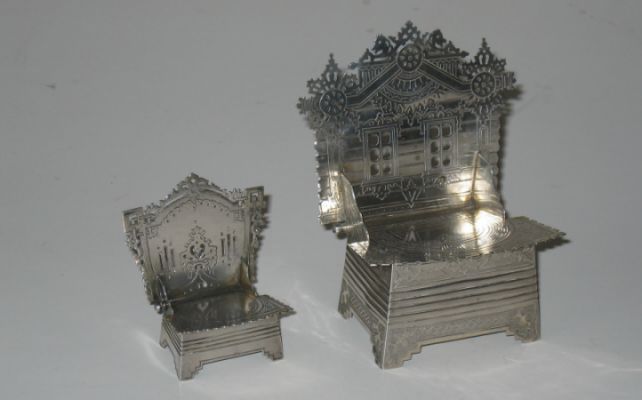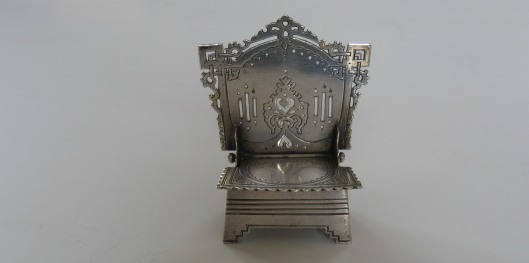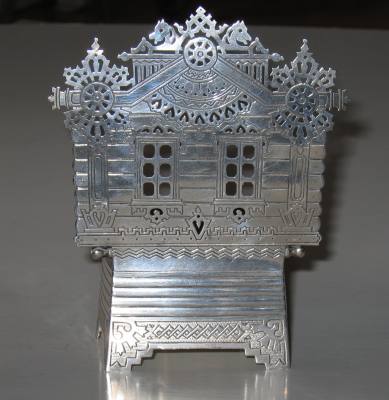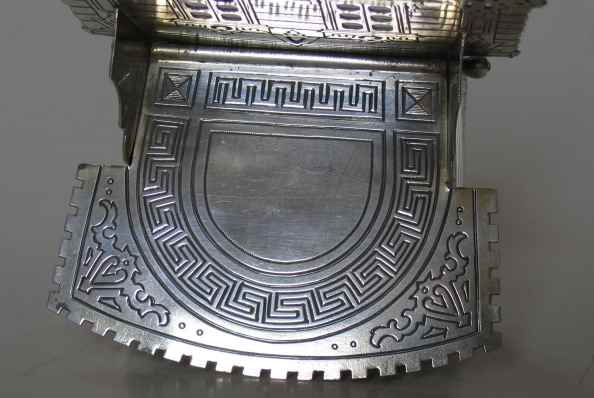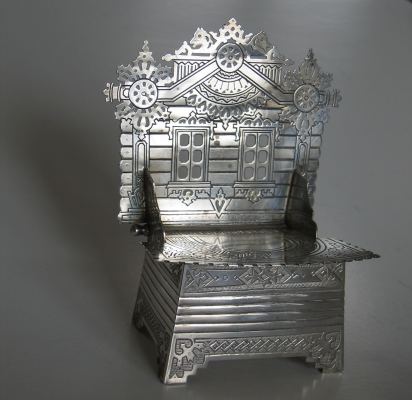 ASSOCIATION OF SMALL COLLECTORS OF ANTIQUE SILVER
ASSOCIATION OF SMALL COLLECTORS OF ANTIQUE SILVERASCAS
| article # 60 |
|
next |
previous |
(click on photos to enlarge image)SALT THRONES FROM RUSSIA
|
Salt throne by silversmith Alexander Fuld, Moscow 1890, assay-master A. Romanov, silver content 84 zolotnik (875/000), gold plated inside, height 7.7 cm, width 6.7 cm, depth 3.2 cm, weight 66.9 grams. The other side of the back is decorated in a manner commisurated with the front. |
The salt ceremony
There is maybe an explanation. This piece was aimed for regular use, if not daily, but of importance in the Russian bread and salt tradition, also known from other regions of Europe. Although ritualized, the salt ceremony was common and salt cellars and salt chairs or thrones were not an uncommon gift for weddings, house-warmings or similar occasions. Sometimes they had an inscription ’Khleb i Solj’ (Bread and Salt) or a greeting.Salt cellars were a traditional gift, symbolizing friendship, intimacy and social definition of both the receiver and the donor.
The gift was, compared to its size, expensive and was intended to be kept as a valuable item as well as for use. The gift reflected social status and wealth. The bigger of the salt throne is of unusual size and probably a presentation salt throne for a well recognised a respected family, maybe aristocratic. The artistic decoration of the throne is extraordinarily rich and in a puristic manner that has often been addressed as Old Russian Style. There are some significant signs and symbols referring to this design tradition. Let us look into the sources.
The style expressed, from where?
Old Russian Style is not particularly old. Rather, it is an eclectic synthesis of what, in the mid 19th century, became a merger of Russian folklore into a style defined as specifically Russian. The intent was to create an original style, separate from the dominant empire style of western European ornamentation and to express this original style with nationalistic, unifying purpose; to establish the concept of ’Rossia Matj’ (Mother Russia) in the art. The aim was to create a unique style based on what was to be regarded as genuine Russian, puristic, not to have been influenced by west but emerging only from genuine Russian soil. The force behind this was Tsar Nicolay I and a raising opinion of nationalism.In the 1830s and 40s a search for sources, rural and pure, began with an examination and sketching of architecture. Pattern books of the style of clothing, wood carving, ornamentation, house wares and smithing details were published. What was found of the origins was, of course, a mix of influences, Byzantine, orthodox and Asian, but also traditional house ware and gift pieces: sudok, kovsh, charka, bratina, and salt cellars. The heritage was rich. Churches and secular buildings revealed previously unnoticed qualities. The style and the idiom thus created was established in Russia as the ’New Russian Style’. When launched at the London Crystal Palace exhibition 1852 as ’Russkii stil’ (Russian style) it became identified as a distinct category of style and was thereafter in use as a marketing term. And here this was exploited by the recognised silversmith Sazikov.
The trend was picked up by prominent artisans and the traditional niello technique from Veliky Ustiug and Tuula had the right robust expression to present peasant people, hunting, houses and landscapes. The silversmith’s workshops following Sazikov, Ovchinnikov and Semionov were rapid to pick up the ideas and some showed up at the exhibitions in Philadelphia 1876 and Fabergé in Paris 1900. In Philadelphia a salt chair in a trompe-d’oeil presentation with a lump of bread and linen napkin was shown to represent and advertise the Russian peasantry salt tradition.
The salt throne interpretation
One expression of the Russian Style in its pure idiom is the small house, or cottage, common in Russian rural areas, the ’izba’. This is a wooden house built of horizontal logs of fir, lark tree or pine with notched corners, and therefore also its size is determined by the length of a log cut in the forest. This kind of house is common in northern Europe where the raw material was easy to access and cheap, often of no expense at all. The construction is simple, self-raising and self-bearing and stands the cold of winter. The roof is also made of logs, sawn to hold rain and snow away, the roof angle designed by experience to carry the weight of snow without sagging down. The gables were the areas which carried the additional decorations or symbols to emphasize the significance of the building, the ’koyok ’, small horse, bird or a wheel carved on the end of the lark tree ridge pole of the roof. Another ornament is the ’nalichnik’, wood-carved window frames. These decorations are of deep significance when applied to salt throne design.The salt thrones were, in one sense, stereotyped, the back or the chair was over-dimensioned thus creating a space for generous decorations. The back offered a squared space for a full representation of an izba gable.
Back of the presentation salt throne of exceptional size, all decorated, the full impression of the izba gable with logs, windows, wheels, birds and the representation of logs also as a cellar flat. The number of logs for the main floor is nine, the traditional number of root logs to create at height of the house for standing upright, 190-210 centimeters. Konyok, nalichnik, wheels and birds are decorative elements present. The ornamental presentation of the izba has a cornerstone counterpoint in the edged square feet of the chair and its chased-work emphasis |
Lid of salt throne seat, traditional Russian style corners and edged frame decorations combined with classical Greek ornaments, an eclectic mix of classic Greek and Russian ornamental heritage |
Presentation Salt Throne, Alexander Josifovich Fuld (1862 - 1917), Moscow 1882, assay master A K, Moscow (endnote), silver content 84 zolotnik (875/000), gold plated inside and at bottom, height 13.2.cm, width 9.2 cm, depth 6.8 cm , weight 194 grams |
Salt chairs or thrones were made in various sizes, there are miniature ones made in fixed combination with tromp-d’oeil arrangements of a piece of bread served; there are important ones made with enamel. The most common are in silver and in the height similar to the first one displayed, 6-9 cm, weighting 50 - 100 grams and in designated various shapes, but on the same standard concept. With this in mind, we can conclude that in the design of these pieces from the workshop of Alexander Fuld, the master stays to the puristic tradition. Both salt thrones are elaborated in heavy-weight silver tin, with exceptional balance in proportions, strong emphasized geometry and artistic ornaments, and the objects are important oeuvres of Russian silversmithing. Although not as recognized as Chlebnikov, Ovchinnikov and others, Alexander Fuld, in his Moscow workshop, created objects of this category that maybe outshine the work of those other masters, particularly in bringing the interpreted late 19th century Russian Style to its most prominent expression.
(endnote) This observation might solve a puzzle in Postnikova-Loseva, the assay master stamp AK of 1882 (No 3865) to a city not known, has now evidence that it is this year to be referred to Moscow. Obviously, there was not one single assay master this year but 2-3, two ended 1881 and another two started 1883 executing the assaying function
Willand Ringborg © - 2006 - |
